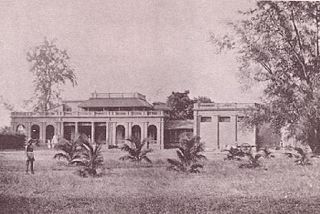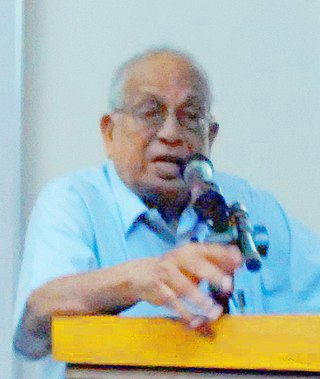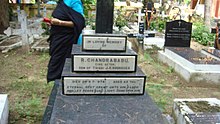
Chennai, formerly known as Madras, is the capital city of Tamil Nadu, the southernmost Indian state. It is the state's primate city both in area and population and is located on the Coromandel Coast of the Bay of Bengal. According to the 2011 Indian census, Chennai is the sixth-most populous city in India and forms the fourth-most populous urban agglomeration. The Greater Chennai Corporation is the civic body responsible for the city; it is the oldest city corporation of India, established in 1688—the second oldest in the world after London.

The Theosophy Society was founded by Helena Petrovna Blavatsky and others in 1875. The designation 'Adyar' is sometimes added to the name to make it clear that this is the Theosophical Society headquartered there, after the American section and some other lodges separated from it in 1895, under William Quan Judge. In 1882, its headquarters moved with Blavatsky and president Henry Steel Olcott from New York to Adyar, an area of Chennai, India.

Adyar is a large neighbourhood in south Chennai, Tamil Nadu, India. It is located on the southern banks of the Adyar River. It is surrounded by the Tharamani in the West, Thiruvanmiyur to the South, Besant Nagar in the East, Kotturpuram in the North-West and Raja Annamalai puram in the North past the Adyar River. Adyar is one of the costliest areas in Chennai with property values four times the value of similar sized properties in the northern part of Chennai. The Gandhi Nagar region of Adyar is one of the poshest localities in Chennai.

The Buckingham Canal is a 796 kilometres (494.6 mi)-long fresh water navigation canal, that parallels the Coromandel Coast of South India from Kakinada City in the Kakinada district of Andhra Pradesh to Viluppuram District in Tamil Nadu. The canal connects most of the natural backwaters along the coast to Chennai (Madras) port.

The Madras Presidency, or the Presidency of Fort St. George, also known as Madras Province, was an administrative subdivision (presidency) of British India. At its greatest extent, the presidency included most of southern India, including the whole of the Indian state of Andhra state, almost whole of Tamil Nadu and some parts of Kerala, Karnataka, Odisha and the union territory of Lakshadweep. The city of Madras was the winter capital of the Presidency and Ooty, the summer capital. The coastal regions and northern part of Island of Ceylon at that time was a part of Madras Presidency from 1793 to 1798 when it was created a Crown colony. Madras Presidency was neighboured by the Kingdom of Mysore on the northwest, Kingdom of Cochin on the southwest, Kingdom of Pudukkottai in the Center and the Kingdom of Hyderabad on the north. Some parts of the presidency were also flanked by Bombay Presidency (Konkan) and Central Provinces and Berar.

Subbiah Muthiah,, was an Indian writer, journalist, cartographer, amateur historian and heritage activist known for his writings on the political and cultural history of Chennai city. He was the founder of the fortnightly newspaper Madras Musings and the principal organizer of the annual Madras Day celebrations. Muthiah was also the founder-President of the Madras Book Club.

Tholkappia Poonga or Adyar Eco Park is an ecological park set up by the Government of Tamil Nadu in the Adyar estuary area of Chennai, India. According to the government, the project, conceived based on the master plan for the restoration of the vegetation of the freshwater ecosystems of the Coromandel Coast, especially the fragile ecosystem of the Adyar estuary and creek, was expected to cost around ₹ 1,000 million which will include the beautification of 358 acres of land. The park's ecosystem consists of tropical dense evergreen forest, predominantly comprising trees and shrubs that have thick dark green foliage throughout the year, with over 160 woody species, and comprises six vegetative elements such as trees, shrubs, lianas, epiphytes, herbs and tuberous species. The park was opened to public by Chief Minister M. Karunanidhi on 22 January 2011 and named after the renowned Tamil scholar Tholkappiar. About 65 percent of the park is covered by water and artefacts and signages. In the first 2 months of its inauguration, nearly 4,000 children from several schools in the city and the nearby Kancheepuram and Tiruvallur districts have visited the park to learn about wetland conservation, eco-restoration and water management. While the first phase of the ecopark covered about 4.16 acres of CRZ-III area, the entire area covered under the second phase falls under this category.

Chennai is located at 13.04°N 80.17°E on the southeast coast of India and in the northeast corner of Tamil Nadu. It is located on a flat coastal plain known as the Eastern Coastal Plains. The city has an average elevation of 6 metres (20 ft), its highest point being 60 m (200 ft). Chennai is 2,184 kilometres (1,357 mi) south of Delhi, 1,337 kilometres (831 mi) southeast of Mumbai, and 1,679 kilometers (1,043 mi) southwest of Kolkata by road.
Cholamandal Artists' Village is an artists' commune in Chennai, India. Established in 1966, it is the largest artists' commune in India. The community is located in the southern coastal neighborhood of Injambakkam. Its artists are credited for the Madras Movement of Art (1950s–1980s), which brought modernism to art in South India. Their work is widely recognized as some of the best art produced in postwar India and is shown regularly in galleries across the country. Several Cholamandal artists have also shown in Europe, the United States and South America.

The Adyar River, originating near the Chembarambakkam Lake in Kanchipuram district, is one of the three rivers which winds through Chennai (Madras), Tamil Nadu, India, and joins the Bay of Bengal at the Adyar estuary. The 42.5-kilometre (26.4 mi) long river contributes to the estuarine ecosystem of Chennai. Despite the high pollution levels, boating and fishing take place in this river. The river collects surplus water from about 200 tanks and lakes, small streams and the rainwater drains in the city, with a combined catchment area of 860 square kilometres (331 sq mi). Most of the waste from the city is drained into this river and the Cooum.

Chepauk Palace was the official residence of the Nawab of Arcot from 1768 to 1855. It is situated in the neighbourhood of Chepauk in Chennai, India and is constructed in the Indo-Saracenic style of architecture.

Madras Club, or Adyar Club, is a gentleman's club in the city of Chennai, India. Founded in 1832, it is the second oldest of its kind in India.

Ekambareswarar Temple, Chennai is a Hindu temple situated in the neighbourhood of Parry's corner, Chennai, India dedicated to Lord Shiva. It was constructed by Alanganatha Pillai, chief merchant of the Madras factory of the British East India Company.

Thenral, earlier known as Brodie Castle, is a house in Chennai, India. Named after civil servant James Brodie (1769-1801) who constructed the house in 1796, it currently houses the School of Carnatic music.

The Senate House is the administrative centre of the University of Madras in Chennai, India. It is situated in Wallajah Road, along Marina Beach. Constructed by Robert Chisholm between 1874 and 1879, the Senate building is considered to be one of the best and oldest examples of Indo-Saracenic architecture in India.

Rajaji Hall, previously known as the Banqueting Hall, Madras, is a public hall in the city of Chennai, India used for social functions. The hall was built by John Goldingham to commemorate the British victory over Tipu Sultan in the Fourth Anglo-Mysore War.

Elphinstone Bridge is a bridge across the Adyar River in Chennai, India. Constructed in 1840 and named after the then Governor-General of India, the bridge is currently not in use and has been substituted with the newly built Thiru Vi. Ka. Bridge nearby.
The Battle of Adyar took place on 24 October 1746. The battle was between the French East India Company men and Nawab of Arcot forces over the St. George Fort, which was held by the French. It was part of the First Carnatic War between the English and the French.
Damarla Chennapa Nayakar was a Nayakar ruler of Kalahasti and Vandavasi under the suzerainty of Vijayanagar emperor Venkatapati Raya. He was also the Dalavoy or the Commander-in-Chief of the emperor. The line of Nayakars were chieftains during the Vijayanagar empire and attained full power after its decline, becoming independent Nayakars.

Adyar Creek is a backwater estuary located in Adyar, Chennai at the mouth of the Adyar River along the Coromandel Coast of the Bay of Bengal. The creek begins near the Chetinnad Palace, extending northward into the mainland and taking a complete U-turn near the Foreshore Estate before ending near Mandavelipakkam. The creek surrounds the Quibble Island.



















